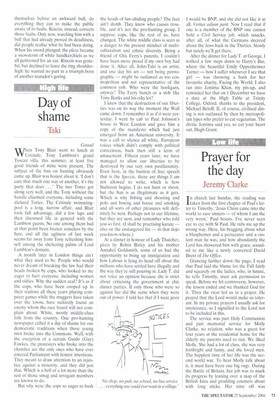French favourite
Daniel Hannan
British people are often surprised to learn that bullfighting is practised in France. They are even more surprised to discover that it is generally of a higher quality than in Spain. The southern French plazas contract the best matadors and the fiercest breeds of bull: Miura and Cebada Gago, Palha and Victorino. And French spectators have one great advantage over Spaniards: they do not believe that expertise about the fiesta runs in their blood and, consequently, they are prepared to study it.
It is hard to stress quite how important this is. I can think of no other activity where the crowd plays as central a role as at a corrida. The closest thing to a `seoreline' in the bullfighting reports is the record of the audience's reaction to each performance: 'two ears', 'light applause', 'whistles', 'rage'.
Since no artist will be better than his public, at least not for long, the temper of the crowd tends to dictate events in the ring. If a matador thinks that he can get away with tricks, then that is what he will offer, dropping theatrically to his knees when he judges it safe, swanking about in the bull's blind spot, thrusting his groin at it once the horns have passed so as to smear himself with blood. In order to get the best out of him, you need a crowd that responds to slow, close, classical capework.
I have just come back from Beziers, France's third bullfighting town. It can't quite compete with Nimes or Arles, whose cortidas are held in Roman amphitheatres. But it had a particular attraction for me: its opening com'da was to feature the Columbian matador, Cesar Rincon.
I first heard RincOn's name when I was an undergraduate in 1991. That year, he did something that had never been done before, and will surely never be done again: he triumphed four times in a row in Madrid. It is difficult to convey what an achievement this is. A matador is awarded a triumph when he has cut two ears from his animals, and Madrid, conscious of its status, is the hardest place in the world to cut ears. Since the 1970s, the plaza has been disfigured by a claque of oafs, concentrated in section seven of the stands, who make it their business to protest every bull and hoot derision at every matador. For a foreigner repeatedly to triumph in such an atmosphere was little short of miraculous, and the taurine world craned forward expectantly.
Rine& never lived up to that summer's promise. Now we know why. Last year, he revealed that he had been suffering from a rare strain of hepatitis, contracted from a blood transfusion after a goring. His doctors had given him a choice: he could give up toreo while they cured him, or they could suppress the symptoms and allow him to carry on below strength. He chose the second option, and struggled on before an increasingly disappointed public. This year, though, he is fully recovered, and triumphing in ring after ring.
I was especially looking forward to seeing him in Beziers, a plaza where he has always had what toreros call 'cartel': rapport with the local public. Yet, when he faced his first bull, the crowd was strangely cold. I put it down to the bull: it was an awkward creature, with a defective right eye, making it unmanageable on that side. RincOn saw this at once, and worked it exclusively on his left — which, as regular readers of this column will know. is far more meritorious. The audience, though, couldn't see what was happening, and made no allowances for the quality of the animal.
With his second, he was magical. Rine& has a very personal style: he incites the bull to charge at huge distances, and then slows it in the cloth, dragging his arm gently backwards without shifting his feet. It is a beautiful thing to see: the animal hurls itself forward at full pelt and then, as the red serge retreats before it, seems to follow in slow motion, bewitched by the movement. Watching, I began to feel the tightness in my throat that comes from pure toreo. Yet still the audience was unmoved, granting an ear in an almost perfunctory manner.
That should have been that. But the evening was not over. The third matador, Magas Tejela, was tossed while performing a filigree cape manoeuvre called a tafallera. The horn sank six inches into his leg and he was carried off, white with shock. When this happens, it falls to the senior matador to take over, and I am ashamed to write that my concern for Tejela was outweighed by my pleasure at seeing Rine& come back into the ring.
It was the nastiest bull of the evening and, having caught Tejela, it knew how to look for the man rather than the cloth. No one would have blamed Rine& for moving briskly to the kill. Instead, he gave us the same delicate, protracted toreo that he had offered his own bulls. At long last, the crowd roused itself, and suddenly I understood what had been holding it back. The Columbian had been making everything look too easy. Most matadors, finding themselves before an awkward bull, do everything they can to make the public aware of its faults. Rine6n, instead, corrects those faults. Only now, watching him with a hull that had already proved its deadliness, did people realise what he had been doing. When his sword plunged, the plaza became a snowstorm of white handkerchiefs as we all petitioned for an ear. Rinc6n was grateful, but declined to leave the ring shoulderhigh: he wanted no part in a triumph born of another matador's goring.



























































































 Previous page
Previous page